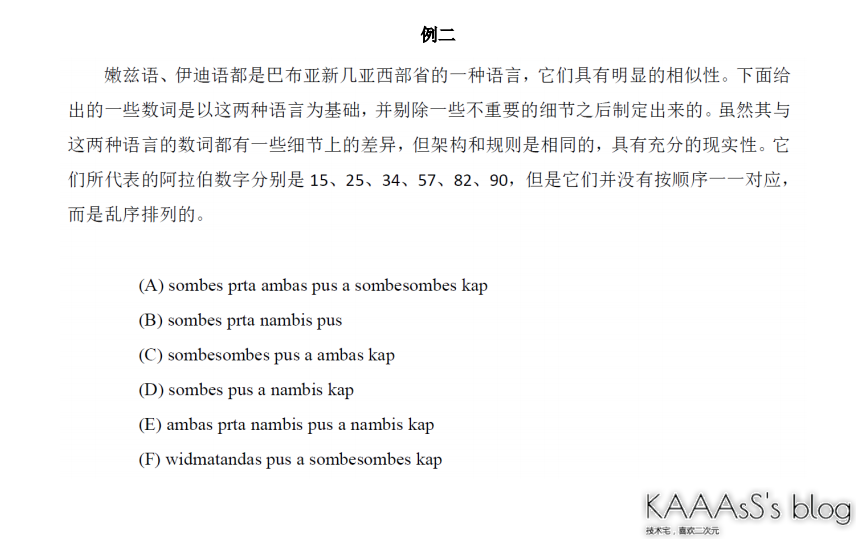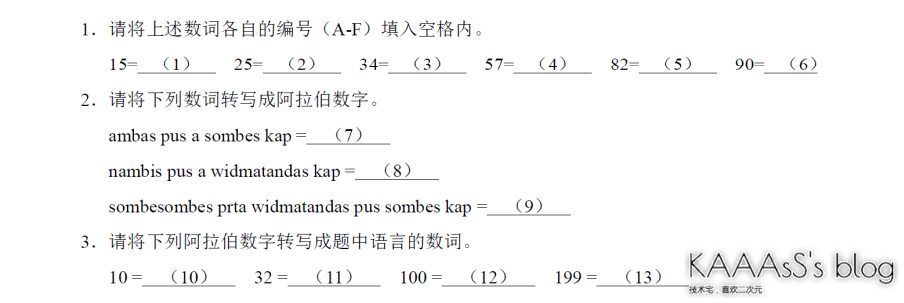Article directory [hidden]
Say in front
I wrote earlier about the mathematical problems in the linguistics competition On base system in language from Ndom language Has simply said a little, but did not do a detailed problem-solving analysis. Later, I always planned to write a blog post to roughly analyze the problem-solving ideas of such problems, but I haven't had enough time to write it (in fact, I don't have 2333 now). This week just @ Huizi mentioned it, so I'm sorry to keep dragging on and update it slowly. Now let's start with a simple question.
Try one question first
Examples of questions from NOL's official website:


When you get the title, you should first notice that the information in these words is more important. More information entropy theory, with a particularly high frequency, is generally not information with a large amount of information. prta, pus and kap all appear very ordinary, so it is speculated that these words should not represent any figures. Next, we need to determine the base and pronunciation of the language, so we make statistics on the beginning and end of the word:
Prefix (the number after it is the number of occurrences) sombes 3 sombesombes 1(Suspected sombes Deformation) ambas 1 widmatandas 1 Suffix sombesombes 2(Suspected sombes Deformation) ambas 1 namhis 3 Statistics There are 5 numbers in total
Obviously not decimal. Generally, languages that appear in linguistic competitions, even IOL, generally have some different "physique" of "people". Due to space constraints (in fact, you are too lazy to calculate ← it's obvious that you calculate mathematica ← shut up) only 6-8 decimal numbers are listed here:
Decimal: 15, 25, 34, 57, 82, 90 Hex: 23, 41, 54, 133, 214, 230 Hex: 21, 34, 45, 111, 145, 156 Octal: 17, 31, 42, 71, 122, 132
Obviously, only hex matches (only 5 numbers also hint at us), and we make sure that the numbers are read from left to right by the way. The numerical table is as follows:
ambas 1 (guess, the same reason as 4) sombes 2 (first 3 occurrences) Sombes sombes 4 (it is obviously a deformation of sombes. It is reasonable to guess 4 between uncertain 1 and 4. The accuracy of the guess can be proved by observing all the figures) namhis 3 (there is no tail at the beginning, which occurs 3 times. Note that when the last bit is 0, we can assume that the last bit may not be 0, but the last non-0 bit) widmatandas 5 (head with tail without)
Moreover, through this table, we not only get all the digits, but also find out the representation of carry. "somhes prta namhis pus" (only 230 ends with 0, and only the word ends without kap) means 230. Then it can be guessed that pus represents ten bits, and a bit is likely to need kap tail. There are three "hundreds" in all numbers, including three prta, so prta should be the sign of hundreds.
Let's write the title below. The first question should be very simple to speculate about the current situation. The table above shows:
15=23⁶= sombes pus a nambis kap =D 25=41⁶= sombesombes pus a ambas kap =C 34=54⁶= widmatandas pus a sombesombes kap =F 57=133⁶=ambas prta nambis pus a nambis kap =E 82=214⁶=sombes prta ambas pus a sombesombes kap =A 90=230⁶=somhes prta namhis pus =B
Translation of the second question, according to the rules:
7. ambas pus a sombes kap =12⁶=8 8. nambis pus a widmatandas kap =35⁶=23 9.sombesombes prta widmatandas pus sombes kap =452⁶=176
The number translation of the third question is still in accordance with the rules (don't forget to add a in the word pus, and don't add it at the end of the word, and don't add it before 9 prompts sombes):
10.10=14⁶= ambas pus a sombesombes kap 11.32=52⁶= widmatandas pus sombes kap 12.100=244⁶= sombes prta sombesombes pus a sombesombes kap 13.199=531⁶= widmatandas prta nambis pus a ambas kap
Look at the answer again, panic.

First, there is a before sombes of 11. Brother, isn't there nothing in your question (9)? Why is it here again? Secondly, why didn't there be a kap at the end of 12 and 13? In the title, sombes and ambas are also at the end of a and C, but kap is added. Besides, there is no reason (I can't see it anyway) not to add kap. Sure enough, I'm not good enough. About this question, we have asked the NOL Organizing Committee... Well, come and update as soon as you have a reply. -– According to the reply of the organizing committee, it seems that the problem is the subject. In short, our reasoning should be correct.
Question type
According to the routine of 5.3, a good friend and teacher of the people, let's analyze the question types of this kind of questions:
Question type | describe | Example |
|---|---|---|
Disordered correspondence | Provide a language representation of some Arabic numerals and their corresponding disorderly arrangement | NOL example T2, IOL2007T4, UKLO2016R2T3 |
expression | Provide some arithmetic expressions expressed in a language | IOL2015T1,NACLO2009(L) |
contrast | Provides a comparison of equivalent descriptions in two languages | IOL2015T1,NACLO2009(L) |
Strange shape (← what the hell) | Topics usually incorporate some magical elements | NaClO 2014 (a) (time), uklo 2015r2t2 (number crunching game) |
Problem solving strategies
To be continued ← not necessarily